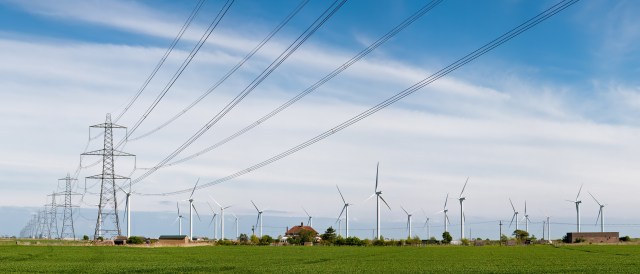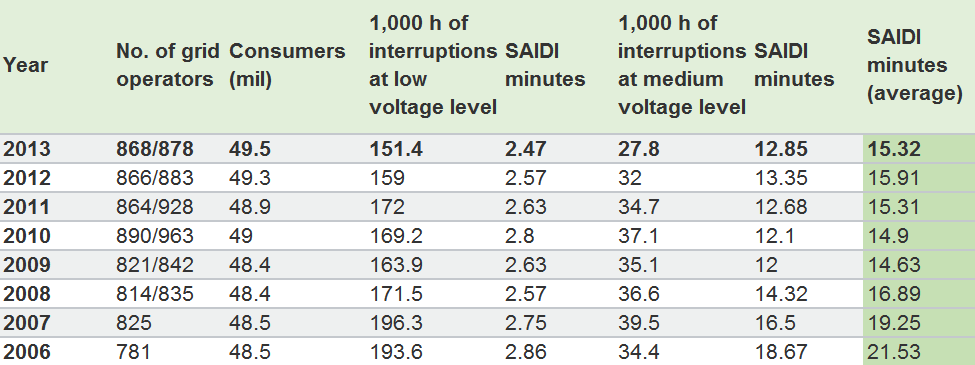It’s bad news for the folks insisting that renewables are wreaking havoc on the grid – last year, the average number of minutes of power outages in Germany fell below the already leading level of 2012 and below the average over the past seven years. Craig Morris looks into the situation.

Even though critics often paint scary scenarios, growth in renewable energy and grid stability are no opposites at all. (Photo by David Iliff, CC-BY-SA 3.0)
On Friday, Germany’s Network Agency announced (press release in German) that the SAIDI value for the country fell from 15.91 minutes in 2012 to 15.32 minutes last year. Though not without its critics, SAIDI has become the internationally recognized way of measuring grid reliability. In this calculation, power outages must last at least three minutes to be counted, and natural disasters are not included.
In 2006, Germany began using SAIDI as a way of reporting grid reliability as a part of an EU-wide effort to facilitate data comparisons. The average from 2006 to 2012 for Germany is 16.91 minutes, roughly 10 percent above the level in 2013 (low numbers are better).

Source: German Network Agency
Despite the overall improvement, the press release also states that “interruptions due to feedback effects” from both the underlying low-voltage and superordinate high-voltage grids increased considerably at the medium-voltage level for the third year in a row. These interruptions could be the result of the increase in distributed renewables, with most wind power connected to the medium-voltage grid and most PV connected to low-voltage lines.
But the press release denies any detrimental effects from the Energiewende, explaining instead that these feedback effects can also come from “consumption systems or an interruption in power supply from power plants.” “No considerable influence of the Energiewende and the concomitant increase in distributed generation capacity on supply quality was detected in the year under review,” the president of the Network Agency Jochen Homann states in the press release, which attributes the SAIDI improvement to a decrease in outages caused by third parties (vehicles, construction work, etc. disturbing power lines and cables). “German power supply remains very reliable, even in comparison to other European countries,” Homann adds.
It also remains very reliable in comparison to the US, though the Network Agency does not make that comparison – probably for a lack of data. The US does not collect reliable power outage statistics – SAIDI or otherwise – but all indications are that Americans easily put up with 10 times as many minutes of power outages on average per year.

Germany’s SAIDI is among the lowest in a comparison with neighboring countries and the US.
In other words, since 2006 we have witnessed a stabilization of Germany’s impressively reliable grid even as some 35 gigawatts of solar and 35 gigawatts of wind were installed on a grid with peak demand of generally around 60-70 gigawatts. Clearly, installing the equivalent of 100 percent of peak demand as wind and solar capacity does not bring down the grid. At the same time, the main correlation with low SAIDI seems to be the amount of underground cabling (as opposed to overhead lines), not the share of renewables, as I explained last year.
The news may come as a surprise to international critics of the Energiewende. The same day of the press release, the Institute for Energy Research (IER) – an organization that seems afraid the German energy transition might work – posted an article on Canada Free Press arguing that “the outcome [of the Energiewende] for Germans will be a higher potential for blackouts” based on the skyrocketing number of grid intervention events, which roughly increased fourfold from 2010 to 2012.
There may yet be something to this concern, however. I once provocatively asked a representative of a transit grid operator to explain what a “grid intervention” on the part of a grid operator means: “so instead of merely sitting there looking at screens, the engineers now have to press buttons?” “Yes,” the expert answered with a wry smile, “and each time they have to do so, there is a slight chance of an error, especially human error.”
Craig Morris (@PPchef) is the lead author of German Energy Transition. He directs Petite Planète and writes every workday for Renewables International.
This result is not very surprising, since wind and solar energy is provided by a multiplicity of distributed sources that can be predicted by meteorologists several hours in advance. Large power plant breakdowns, by contrast, are often unexpected occurrences. Many accounts I’ve heard on working conditions in lignite power stations sound pretty stressful. That includes the fact that accumulated slag in the firebox has to be blasted out every couple of weeks with TNT. Lignite is an extremely inexpensive fiel, but generating electricity from it is infernal business.
SAIDI is the wrong way to measure the impact of renewables to the grids. As said in the article, the main reason SAIDI has gone down is that third parties, such as vehicles and construction sites, have caused less damage to power lines.
The right way? Number of interventions needed to balance the grid when renewable power supply fluctuates, which has clearly gone up:
“Germany’s push toward renewable energy is causing so many drops and surges from wind and solar power that more utilities than ever are receiving money from the grids to help stabilize the country’s electricity network.
Twenty power companies including Germany’s biggest utilities, EON SE and RWE AG, now get fees for pledging to add or cut electricity within seconds to keep the power system stable, double the number in September, according to data from the nation’s four grid operators. Utilities that sign up to the 800 million-euro ($1.1 billion) balancing market can be paid as much as 400 times wholesale electricity prices, the data show.
Tennet TSO GmbH, Germany’s second-biggest grid operator, told power plant operators to adjust output 1,009 times to keep the grid stable last year, compared with 209 times in 2010.
http://www.bloomberg.com/news/2014-07-24/german-utilities-bail-out-electric-grid-at-wind-s-mercy.html
In this article, SAIDI is measured for impact. Others have measured cost of frequency control.
Are these the right measures?
Here’s some thoughts:
http://www.wattclarity.com.au/2014/08/privatising-profits-whilst-socialising-costs-part-1/